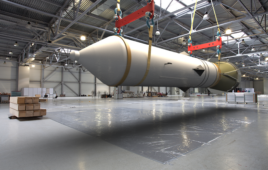Failure is Not an Option in the Military Market
In recent years, unmanned vehicles, be they the Predator Drones that we watch on the evening news letting loose with pinpoint-precision Hellfire Missiles that take out enemy targets from high above the earth; a bomb-detecting/disposal ground vehicle that keeps soldiers and law enforcement people out of harm’s way; or a remotely controlled underwater vehicle from the U.S. Navy that made it possible to finally lift the veil of mystery that had shrouded the legendary RMS Titanic for decades, have become highly visible success stories.
The old saying of necessity being the mother of invention was never truer than in the combat theaters of Afghanistan and Iraq, where the role that unmanned aerial vehicles (UAVs) have played in combat and surveillance scenarios has, by anyone’s measurement criteria, been a raging success. They have ushered in a new kind of high-tech warfare that has delivered astounding results.
The efficiency and accuracy of these unmanned vehicles has had the effect of striking terror in the hearts of the terrorists themselves while at the same time saving the lives of countless numbers of American and allied soldiers. As such, in the era where U.S. defense spending is uncertain, the investment made by the military in unmanned research, development and deployment is returning a strong ROI.
Many Factors Will Drive the Unmanned Sector
Driving factors in the unmanned sector(s) will continue to be size, weight, bandwidth, security, ability to operate under extreme harsh conditions, and power and propulsion.
- Size and weight will be addressed in numerous ways including the use of composite materials, the development of connectors that can carry a variety of contact types (signal, power, RF, microwave), as well as a switch from copper cable to much lighter fiber optic cable.
- Use of fiber optics will continue to grow not only because of its superior information carrying capacity, reduced attenuation, and immunity to EMI, but also because it offers greatly reduced size and weight over traditional copper as well as a more secure connection.
- Increased demand for unmanned airborne Intelligence, Surveillance and Reconnaissance (ISR) systems; in the next few years, we will see continuous and steady growth in the construction and production of UAVs.
- Radar applications are data centric and are driving high speed architectures including connector/interconnect solutions. According to a new market report from Frost and Sullivan (www.frost.com), the radar systems and subsystems market will be $2.47 billion in 2011 — an increase of $212 million over 2010. Across all services and platforms, radar systems are 5.7 percent of the total military spending, with the largest segment of military spending on command, control, communications, computers, intelligence, surveillance, and reconnaissance (C4ISR).
- The success of UAVs will spark further development of unmanned maritime vehicles (UMV) and unmanned ground vehicles (UGV). Both of these will require interconnect solutions that can operate in extreme harsh environments. Underwater connectors, both electrical and fiber optic, should also see substantial growth.
- Propulsion and power are major topics in unmanned platforms. The rapid development and deployment of unmanned systems has resulted in a corresponding increased demand for more efficient sources for propulsion and power. In addition to increasing mission time, improvements in propulsion and power have the potential to significantly reduce life cycle costs. Also, current limitations must be overcome to enable ‘long endurance’ platforms.
Interconnects Must Address the Needs of Next-Gen UAVs
The military is definitely pushing the envelope in its quest for suppliers to furnish new designs and improvements for next-generation unmanned aircraft that will provide greater range and capacity which defines a set of new and greater technological requirements for interconnect solutions.
UAV success is driving the demand for multiple ruggedized unmanned platforms with diverse missions that deliver higher volumes of data at faster speeds and is impervious to shock and vibration. Ruggedization, enhanced speed and a smaller footprint are today’s key challenges. These evolving demands and requirements need to be supported by “the connector/interconnect solution.” The interconnect solution represents a key ingredient in the recipe for success. In the final analysis, the weakest link in embedded applications can NOT be the interconnect solution, because it is responsible for ensuring and safeguarding the uninterrupted flow of critical data.
The contribution that UAVs make in hostile situations speaks volumes in terms of their ability to minimize casualties while at the same time sending the clear message to enemy combatants that they can run, but they cannot hide. The military market is a venue where failure is simply not an option, and enhanced technology continues to usher-in a new era of remote control warfare that makes it possible for the American military to strike an enemy from a greater and safer distance.
Interconnect solutions providers are responding to the changing demands of demanding military applications. Companies like Hypertronics Corporation, for example, are delivering differentiated rugged connectors that are:
- Impervious to Mechanical Shock & Vibration – a prerequisite for mil-aero platforms.
- Conducive to level 2 maintenance requirements – lower system cost of ownership.
- Self wiping action due to 360° of contact points – required due to “dirty” environment.
- Extremely low insertion/extraction force – important, because of the high number of pins.
- Rated for higher electrical current to allow higher power throughput, therefore minimizing or negating increases to contact size and pitch.
- Lower electrical resistance (than conventional contact designs) – reduces the required power input to overcome resistance in the circuit (connector).
- Long contact life cycle in the field – lower system cost of ownership.
Conclusion
In conclusion, the military and aerospace market is indeed an arena where failure is simply never an option, and the same case must now hold true as unmanned technology expands dramatically. Enhanced technology has ushered-in a new era of remote control capabilities that come with ever-changing requirements across multiple disciplines. Inability to keep pace with these changes translates to failure, and one thing that remains crystal clear is the United States military is very definitely not going to fail. We live in times that are interesting, exciting, and that present us with an array of daunting challenges that keep us ‘on alert’ as new technologies continue to evolve.
For more information visit www.hypertronics.com.
Filed Under: Aerospace + defense




